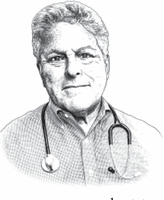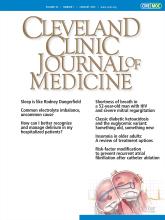
The actor and comedian Rodney Dangerfield (1921–2004) was best known for his signature line, “I don’t get no respect.” If sleep were ever to deliver a monologue on late-night television, the same line would be apropos.
From my conversations with patients in the office or with friends over dinner, it seems almost no one is happy with their quality of sleep. Based on data from the National Health and Nutrition Examination Survey, the prevalence of participants with trouble sleeping was estimated by Nie et al1 to be about 30% in 2018. The percentage of patients I see in rheumatology clinic for evaluation of generalized pain, “brain fog,” and unexplained fatigue is strikingly high. Some have had a detected, but unrelated, circulating antinuclear antibody; almost all characterize their sleep as suboptimal.
And yet, there seems to be resistance in many patients and clinicians to accept a significant link between their malaise and pain and their sleep disorder. From the clinician’s perspective (once malignancy and inflammatory, infectious, and metabolic disorders are reasonably believed to be unlikely), this management challenge is compounded by the fact that we don’t have uniformly effective therapies to correct dysfunctional sleep. This challenge, as discussed in this issue of the Journal,2 can be particularly vexing in the elderly. But there are successful approaches.
Sleep is a fascinating biologic phenomenon. There is a complex interplay between different anatomic areas of the brain that modulate wakefulness and the need for sleep. Identification of neuromediators in these different areas has resulted in the development of targeted pharmacologic therapies. Sleep in some form seems to be necessary in all species, although it may manifest differently between animals, based in part on their physiology and environmental survival pressures. Some sharks, birds, dolphins, seals, and manatees exhibit unihemispheric sleep, functionally sleeping with 1 eye open. This permits those sharks to keep moving and oxygenating and allows birds and other animals to gain the many benefits of sleep while remaining vigilant for predators.3 Worms require a version of sleep to enable neuroplasticity sufficient to cement beneficial new olfactory learning behaviors,4 and cellular biologic clock–controlled rest and activity cycles, akin to animal sleep and activity, have even been demonstrated in cell tissue cultures5 and amoebae.
In humans and other mammals, sleep quantity (and, in some cases, quality) has been shown to impact memory and learning, mood, appetite, and pain. Many of these biologic effects ring true to those of us who are undergoing or recall the experience of medical or surgical residency. The desire for a large breakfast after a sleep-depriving night on call can be explained as an imbalance between the satiety and appetite-stimulant hormones leptin and ghrelin.6 Acute and reversible attention loss and memory diminution have been demonstrated with acute sleep deprivation,6 while a longer duration of sleep disruption has been linked to neurodegenerative effects, perhaps even including beta amyloid deposition.7 Functional magnetic resonance imaging can demonstrate anatomic areas of reversible metabolic dysfunction associated with sleep deprivation, but a full neurochemical understanding is elusive. An interesting set of observations suggests that a sleep inactivity cycle is necessary for normal and efficient cerebrospinal fluid flow to clear waste molecules from interstitial spaces in the brain.8
Intuitive observation, and review of the above and some additional sleep research, leaves little surprise in recognizing cognitive and neuromuscular impairment in those who are not getting adequate sleep. The airline and other industries (and the Accreditation Council for Graduate Medical Education) have recognized this for years. What is less straightforward, but increasingly recognized in practice and in research settings, is the strong link between sleep quality disturbances and the presence of pain threshold diminution. The concept of central sensitization pain syndromes, or nociplastic pain, is now reasonably well entrenched in the medical literature and clinical practice (CCJM will have a paper devoted to this in the near future). While it is obvious that severe organ or anatomic (nociceptive) pain can lead to poor sleep, it is actually a bidirectional process. Chronic9–11 and even transient, short-term12 sleep disturbances can elicit or worsen pain by reducing the pain threshold and increasing sensitivity to sensory inputs. In studies, this seems to be a reversible effect.13 In practice, reversibility is harder to accomplish, although some of the insights provided by León-Barriera et al2 will hopefully be helpful. I have also found helpful suggestions provided by my patients who, through trial and error and word of mouth, have come upon successful creative strategies of their own, some of which have contradicted our standard teachings. It is certainly worth giving sleep the respect that it deserves—discussing sleep habits and perceived level of sleep satisfaction14 with our patients, particularly those with difficult-to-manage pain, hypertension, and fatigue.
As we have closed out the year 2024, we at CCJM offer our readers, authors, and reviewers our sincere wishes that we can share a healthy, kind, and peace-filled 2025. And in the seasonal spirit of this commentary, I wish to all a good night.
- Copyright © 2025 The Cleveland Clinic Foundation. All Rights Reserved.






